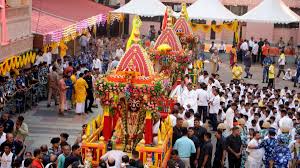In Trinamool vs BJP battle, why Jagannath ‘prasad’ has become a new flashpoint

West Bengal’s politics has taken a sharp turn. A sacred offering—Jagannath prasad—is now at the center of a fierce clash between the Trinamool Congress (TMC) and the Bharatiya Janata Party (BJP). What began as a religious practice during Rath Yatra has turned into a high-voltage political issue. Both parties are using it to push their narratives, especially with elections on the horizon.
Jagannath Prasad Moves from Temple to Campaign
Lord Jagannath’s Rath Yatra, traditionally celebrated in Odisha, is gaining ground in Bengal. This festival includes the distribution of prasad (holy food), considered sacred by devotees. In 2024, BJP leaders started offering prasad across Bengal during Rath Yatra. They framed it as a gesture to bring blessings and cultural unity.
However, TMC leaders were quick to respond. They accused the BJP of turning a sacred ritual into a political stunt aimed at influencing Hindu voters. According to TMC, the BJP was not promoting devotion but imposing Odisha’s religious culture on Bengal.
TMC’s Pushback: Defending Bengal’s Cultural Identity
Trinamool leaders criticized the BJP’s prasad distribution drives. They claimed the BJP was trying to import Odisha’s religious identity to Bengal for political gain. Bengal, they argued, has its own strong spiritual roots—centered around Durga, Kali, and Bhakti movement saints.
TMC countered the BJP’s efforts by organizing its own food drives during local festivals. These events highlighted Bengali traditions, distancing the ruling party from what they called an “outsider” religious campaign.
BJP’s Response: Calling Out “Religious Insult”
The BJP fired back with sharp accusations. They said the TMC was disrespecting Hindu beliefs and blocking or discouraging prasad distribution in some areas. BJP leaders framed this as another example of the TMC’s appeasement of minority communities.
According to BJP, distributing Jagannath prasad was not about politics but about faith. They insisted they had every right to celebrate religious traditions—regardless of where they started.
The Real Fight: Religion Meets Regional Identity
At the heart of the issue lies a deeper question: Whose culture defines Bengal? Lord Jagannath holds deep spiritual meaning in Odisha, while Bengal’s own traditions revolve around local deities and saints. TMC sees the BJP’s Jagannath push as an attempt to dilute Bengal’s cultural uniqueness.
To push back, Mamata Banerjee has focused on Bengal’s spiritual icons. She has recited Chandi Path in public and supported large-scale Durga Puja celebrations. The message is clear—Bengal doesn’t need imported identity symbols.
Religion as a Campaign Strategy
Over the past few years, religion has taken a front seat in Bengal’s politics. The BJP has organized Ram Navami rallies, Hanuman Jayanti events, and temple visits. These tactics aim to consolidate Hindu votes, especially in districts where the BJP made gains in 2019 and 2021.
TMC, once firmly secular, has adjusted its messaging. Mamata Banerjee now openly uses Hindu imagery. While she stops short of embracing hard Hindutva, her approach aims to neutralize BJP’s religious edge.
Odisha’s Influence in Bengal Politics
BJP’s strategy isn’t limited to Bengal. By promoting Jagannath-related events, they are building a pan-Hindu narrative that connects neighboring states. Odisha BJP leaders have joined prasad distribution drives in Bengal, giving the campaign a regional unity angle.
Critics say this move is not about faith but about expanding BJP’s ideological footprint. By tying cultural elements across states, BJP strengthens its nationalist image while gaining ground in key regions.
Why This Flashpoint Matters
At first glance, the fight over prasad may seem symbolic. But it reveals much more. It shows how cultural identity, religion, and electoral politics are deeply intertwined in today’s Bengal. Both parties are fighting not just for votes but for control over public sentiment and regional pride.
For BJP, the strategy is clear—use shared religious symbols to create unity and widen their support base. For TMC, the goal is to protect Bengal’s distinct identity while appealing to the state’s diverse voters.
Conclusion
The Jagannath prasad controversy isn’t just about food or festivals. It’s about which narrative will shape Bengal’s future—one rooted in regional pride or one aligned with a broader Hindu nationalist vision.
As elections draw closer, such symbolic battles will likely grow louder. With both TMC and BJP using religious and cultural tools to woo voters, Bengal’s political stage will remain as charged as ever. And in this battle, even something as sacred as prasad can become a powerful political weapon.le. The line between devotion and strategy is getting increasingly blurred—turning even sacred food into a powerful political statement.






